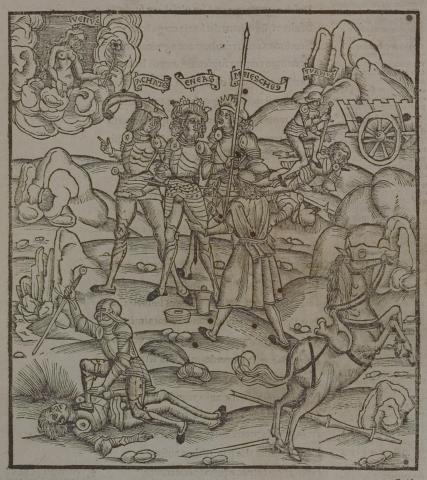Annotations
In the center of the image, Achates and Mnestheus [Mnesches] escort Aeneas away from the fighting (383-6). Ascanius is present in the text, but is not shown in the image. In front of him Iapyx attempts to pull out the arrow and heal the wound with the herbs in the medicine jars at his feet, but in vain (391-410). In the upper left, Venus holds a flower, dittany, which aids in removing arrows from wounds (411-5). To the right of the main scene, and at the bottom of the image, Turnus is shown killing two victims, a representation of his killing spree that occurs from 324-382. The victim in the lower left is most likely Eumedes, whom Turnus attacked first with a spear and then with his sword (346-61).
Woodcut illustration from the “Strasbourg Vergil,” edited by Sebastian Brant: Publii Virgilii Maronis Opera cum quinque vulgatis commentariis expolitissimisque figuris atque imaginibus nuper per Sebastianum Brant superadditis (Strasbourg: Johannis Grieninger, 1502), fol. 399r, executed by an anonymous engraver under the direction of Brant.


Sebastian Brant (1458-1521) was a humanist scholar of many competencies. Trained in classics and law at the University of Basel, Brant later lectured in jurisprudence there and practiced law in his native city of Strasbourg. While his satirical poem Das Narrenschiff won him considerable standing as a writer, his role in the transmission of Virgil to the Renaissance was at least as important. In 1502 he and Strasbourg printer Johannes Grüninger produced a major edition of Virgil’s works, along with Donatus’ Life and the commentaries of Servius, Landino, and Calderini, with more than two hundred woodcut illustrations. (Annabel Patterson)